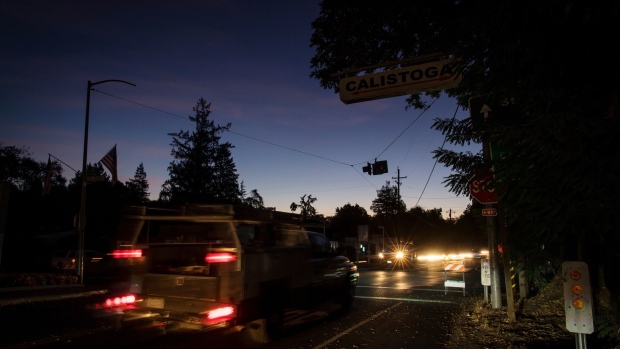Jan 5, 2023
California Wine Town to Fight Blackouts With Batteries, Hydrogen
, Bloomberg News

(Bloomberg) -- A California wine country town plagued by wildfires and blackouts could soon get a backup power supply capable of running most of its homes and businesses for two days on batteries and green hydrogen.
Utility giant PG&E Corp. and Energy Vault Holdings Inc. plan to create a microgrid covering most of Calistoga, a small town of restaurants, tasting rooms and shops at Napa Valley’s northern end. During disruptions on the region’s electrical grid, the microgrid would use a mix of lithium-ion batteries and fuel cells running on hydrogen to supply the town, with no greenhouse gas emissions.
Fuel cells employ an electrochemical process — rather than combustion — to generate electricity, and when fueled by hydrogen, their only emissions are water vapor. Energy Vault will buy the hydrogen, which will be stripped from water using solar power, from a third-party supplier.
PG&E and other California utilities have resorted to shutting off power lines in advance of high winds, following a string of deadly wildfires sparked by their equipment. Such “public safety power shutoffs” repeatedly have hit Calistoga and nearby towns, and fires have menaced their neighborhoods. Hills covered in charred trees from 2020’s Glass Fire loom over Calistoga’s downtown.
The new system will provide protection during public safety shutoffs without resorting to diesel or natural gas generators, said Robert Piconi, Energy Vault’s chief executive officer. The system, which can serve 2,000 homes and businesses, will provide carbon-free power in a place ill-suited to a large solar or wind facility, and its batteries will be able to start supplying energy almost instantly when needed. Although the two companies aren’t revealing an exact price, Piconi said in an interview it will be less than $100 million. The project will require the approval of the California Public Utilities Commission.
“It will be an economical solution to solve use cases that otherwise couldn’t be solved with renewables, and that’s very exciting to us,” Piconi said.
Energy Vault first gained attention for using gravity to store large amounts of energy — far more than lithium-ion batteries can hold. Its gravity-based system uses electric motors to lift large, heavy blocks off the ground, stacking them inside a building whenever electricity is cheap and plentiful, then lowering them and running the motors in reverse to generate electricity when needed. But that system, Piconi said, would not have worked for Calistoga, likely requiring an 18- to 20-story structure that would not have blended into the low-lying town. Calistoga is home to some 50 wineries.
“That wasn’t going to be something, with the community there, that we could propose,” he said.
Construction is expected to begin in the fourth quarter of this year, with service available in mid-2024.
©2023 Bloomberg L.P.





